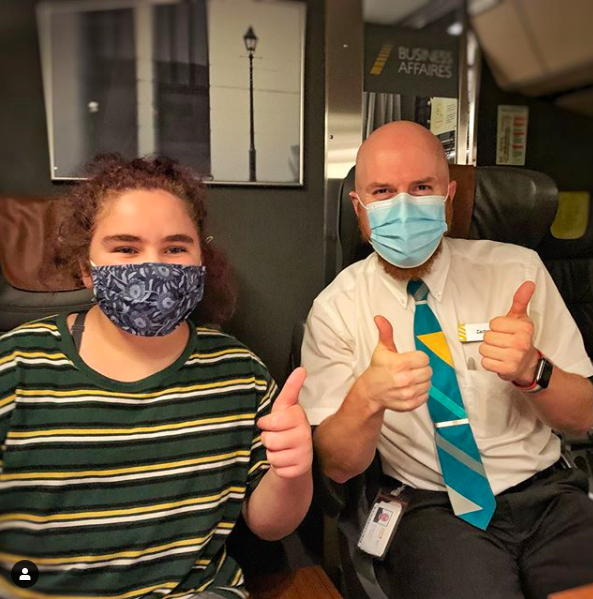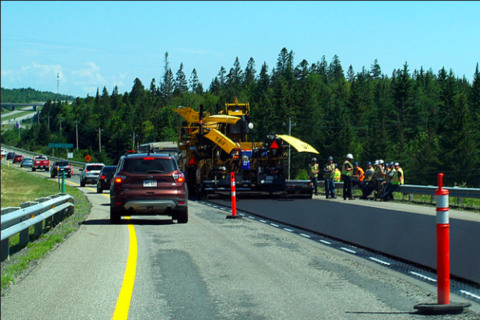The Impacts of COVID-19 on Canadian Domestic Intercity TransitBy Jacqueline BeaudoinIn addition to provincial and regional government differences in quarantine, isolation, mask-wearing, social distancing guidelines, and social gathering limits, Canada’s domestic travel agencies also have imposed standards to reduce the spread of COVID-19. These images aim to provide a more collective understanding about Canadian travel during COVID-19, and insight on the effects of responsive governmental legislations. In particular, to highlight the experiences of travel staff and customers.
Introduction The Coronavirus disease [COVID-19] originated in Wuhan, China, in December, 2019, and quickly spread to over 200 countries through an active travel network. For example, the virus crossed international borders through the air transportation network. Intercity travel has been determined to contribute to the rapid spread of disease, including COVID-19. Moreover, population flow is pertinent to the transmission of COVID-19, as reflected by national and provincial travel restrictions (Zhan et al. 2020). In Canada, public intercity travel agencies have taken measures to ensure the safety of employees and passengers. While intercity travellers continue to commute, intercity highway traffic has been impacted by constructed delays, which has greater implications to the supply-chain needs of Canadians.
Canadian Intercity Travel Agencies Via Rail Canada connects over 400 Canadian communities and transports about 4.8 million passengers annually (Revenues 2019). VIA Rail Canada has taken the following steps to improve the quality of disease prevention during the use of their transportation services: masks are required onboard and in stations, limited seats are available for booking, improved sanitation and cleaning protocols, contactless transaction, and pre-boarding health checks (Via Rail Canada 2020). Pre-boarding health checks became regimented on March 30, 2020, and include simple health questions, visible signs of illness, and the recommendation to passengers of advice from local health authorities (Transportation Canada 2020) Comparatively, Greyhound Canada is the largest intercity bus transportation network in Canada and transports about 6.5 million passengers annually (About 2020). This public transportation service has also updated terms of schedule and service during COVID-19. In particular, service has been suspended to several locations within the United States, in cooperation with the travel restrictions of the federal government. As a result of reduced travel demand, Greyhound is also reducing schedules temporarily, of which the most up-to-date copy can be found at Greyhound.com (Greyhound Canada 2020).
Intercity Highways: Traffic and Construction For intercity travellers who ride Greyhound or a personal vehicle, another way that COVID-19 has impacted their journeys is through road closures and loss of production on construction sites. In March, 2020, Ontario’s state of emergency ordered the closure of all non-essential business, which contributed to a significant decline in traffic across the province. The Ontario Highway 401 is one of North America’s busiest highways, averaging 420,000-500,000 vehicles daily. However, the following weeks major highways were “noticeably empty” (Santa Maria 2020). As the pandemic ensued, the restrictions lessened and highway traffic somewhat steadied. Despite greater freedom of movement, construction delays posed new challenges to COVID-19 travellers.
COVID-19 has generated a number of challenges to Canadian construction companies, including supply delivery issues, work absence due to illness, delayal of permits, travel restrictions, and lost time or inefficiencies related to organizational adjustments (Bennet 2020). The interruption of construction slows down essentials of human life, such as groceries, medical supplies, and intercity highway access.
For the most part, construction activities in Saskatchewan, Manitoba, Alberta, and British Columbia have been classified as essential business, within the order of provincial health guidelines (Bennet 2020). For example, the Canadian Construction Association also issued COVID-19 - Standardized Protocols for All Canadian Construction Sites. Regarding COVID-19, this manual details prevention measures (i.e. monitoring status of workers, working in close proximity, deliveries, etc.), detection measures (i.e. screening at entry zones), response measures (i.e. possible cases of COVID-19 and response plans), and business strategies (Canadian Construction Association 2020). Business is a critical skill pertaining to risk and management, which is relevant to the protection of the health and safety of employees, in the context of a global pandemic. That is, contextualizing the risk of COVID-19 against public health to minimize economic impact. In order to assist in the continuity of construction business and planning, the Canada Construction Association recommends to its members a business guide developed by the Canadian Chamber of Commerce. This manual incorporates relevant and credible business information, best tools, and resources (Canadian Construction Association 2020).
As per provincial governance of public health, the COVID-19 - Standardized Protocols for All Canadian Construction Sites is informed by provincial legislations. For example, the 1983 New Brunswick Occupational Health and Safety Act. Under this regulation, employees have the right to refuse work, on reasonable grounds of risk to their health or safety. In addition, the duty to report, take, or recommend remedial action on reasonable grounds of danger or endangerment (Occupation Health and Safety Act 1983). Each Canadian jurisdiction has a similar version of this document, such as Ontario’s 1990 Occupational Health and Safety Act. With regards to this regulation and any related incidents, the following are advised by the Ontario Chief Medical officer of Health: workers should raise any concerns to their supervisor, joint and safety committee, and/or health and safety representative, to “ensure the employer has taken all reasonable precautions”. During the COVID-19 pandemic, the enforcement of rules concerning the safety of public service employees and customers is critical to prevent the spread of disease; “While the COVID-19 situation is changing rapidly, the legislations used to govern [Ontario’s] workplaces are not” (Government of Ontario 2020).
Conclusion Coinciding with provincial healthcare regulations, each province has designated protocols to minimize the travel-related spread of COVID-19. In general, these are related to quarantine and isolation, mask-wearing, social distancing guidelines, and provincial and regional standards on social gathering limits (Global Affairs Department, 2020). Otherwise, peculiarities exist according to variations in population and other social factors. For example, “travellers arriving in the [Northwest Territories] must mandatorily self-isolate and stay at home for 14 days in Yellowknife, Inuvik, Hay River or Forth Smith only. NWT residents cannot self-isolate in a small community” (Government of the Northwest Territories, 2020). Travellers to PEI must apply for entry, of which acceptable reasons include a court appearance, emergency medical purpose, exceptional or compassionate circumstances, work, or otherwise related to residency or property ownership (Government of Prince Edward Island, 2020).
Research conducted by Zhan et al. proposes a model to predict the spread of COVID-19 disease through intercity travel. An application of this model to confirmed numbers of cases in Japan and the United States, in March, 2020, suggests a 200% and 100% increase in numbers, respectively. Based on findings of a relationship between intercity travel and the spread of COVID-19, heightened travel restrictions are necessary in these countries (Zhan et al. 2020). In Canada, 65% of reported COVID-19 cases are related to community transmission, through travel exposure. Otherwise, intercity travel exposure (Shah 2020). Despite restrictions on national borders, Zhan et al.’s research highlights the importance of heightening the restrictions of domestic independent Canadian travel, to protect the wellbeing of Canadians.
Next Page: Independent Travel.
|

A Via Rail Canada Employee's father visits him at work. Here, they are shown following social distancing guidelines. Photo taken April 24, 2020.
A Via Rail Canada employee preforms magic tricks for passengers, onboard Train 669, from Montreal to Toronto. Photo taken September 6, 2020.
A Vial Rail Canada train passenger wearing a mask onboard. Photo taken October 10, 2020.
Construction workers on the side of Highway 1 in New Brunwick. They do not appear to be following social distancing guidelines or other COVID-19 protocols.
|
References:
About- Greyhound Canada. “About Greyhound.” Greyhound.ca, 2020. https://www.greyhound.ca/en/about/default.aspx.
Canadian Construction Association. (2020). COVID-19 - Standardized Protocols for All Canadian Construction Sites: page 1. Retrieved December 3, 2020 from https://www.newswire.ca/news-releases/government-of-canada-announces-new-domestic-transportation-measures-825623884.html.
Government of Ontario. (2020). Construction site health and safety during COVID-19. Retrieved December 3, 2020 from https://www.ontario.ca/page/construction-site-health-and-safety-during-covid-19
Global Affairs Department, Government of Canada. (2020, September 21). COVID-19 and travel: Crossing provincial and territorial borders. Retrieved October 26, 2020, from https://travel.gc.ca/covid-19-provinces-territories.
Government of the Northwest Territories. (2020, June 24). GNWT's Response to COVID-19. Retrieved October 26, 2020, from https://www.gov.nt.ca/covid-19/en/services/travel-moving-around.
Government of Prince Edward Island. (2020, October 22). Pre-Travel Approval Process. Retrieved October 26, 2020, from https://www.princeedwardisland.ca/en/information/justice-and-public-safety/pre-travel-approval-process.
Greyhound Canada. (2020). COVID-19 Update: Schedule and Service Changes. Retrieved October 26, 2020, from https://www.greyhound.com/en/help-and-info/travel-info/schedule-service-...
Misskey, Bennet. (2020). Covid-19: Construction Delay and Productivity Loss During an Outbreak: Who Bears the Risks? Retrieved December 3, 2020 from https://www.mltaikins.com/construction/covid-19-construction-delay-and-productivity-loss-during-an-outbreak-who-bears-the-risks/.
Occupational Health and Safety Act, SNB 1983, c O-0.2, <http://canlii.ca/t/54qk6> retrieved on 2020-12-02
Revenues- Via Rail Canada. (2019). VIA RAIL: REVENUES AND RIDERSHIP UP FOR Q2 2019. Retrieved October 26, 2020, from https://media.viarail.ca/en/press-releases/2019/30-august-2019-via-rail-...
Santa Maria, Cheryl. (2020). Photos: Empty Ontario highways in the age of COVID-19. Retrieved December 3, 2020 from https://www.theweathernetwork.com/ca/news/article/photos-empty-ontario-highways-in-the-age-of-covid-19-401-qew-403-404-traffic-cameras-toronto-mississauga-niagara-london-sarnia-ottawa.
Shah, Maryam. (2020). 65% of reported COVID-19 cases in Canada related to community transmission: latest data. Retrieved December 3, 2020 from https://globalnews.ca/news/6747218/coronavirus-canada-community-transmission/.
Transportation Canada. (2020). The Government of Canada announces new domestic transportation measures. Retrieved December 3, 2020 from https://www.newswire.ca/news-releases/government-of-canada-announces-new-domestic-transportation-measures-825623884.html.
Via Rail Canada. (2020). COVID-19: Preventive measures. Retrieved October 26, 2020, from https://www.viarail.ca/en/preventive-measures-COVID-19.
Zhan, Choujun et al. “General Model for COVID-19 Spreading With Consideration of Intercity Migration, Insufficient Testing, and Active Intervention: Modeling Study of Pandemic Progression in Japan and the United States.” JMIR public health and surveillance vol. 6,3 e18880. 3 Jul. 2020, doi:10.2196/18880. Retrieved from https://publichealth.jmir.org/2020/3/e18880/.




